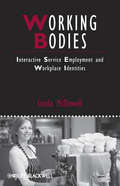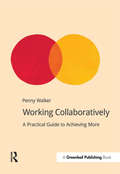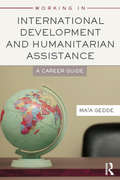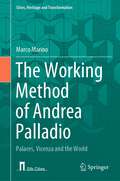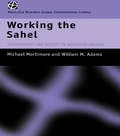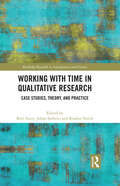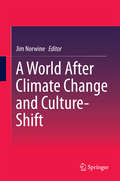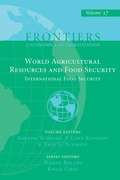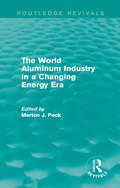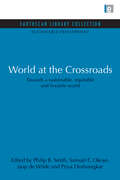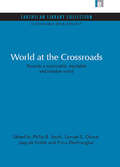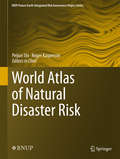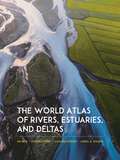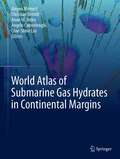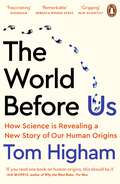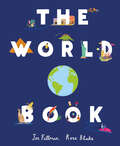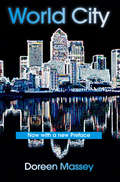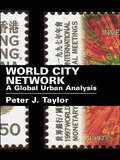- Table View
- List View
Working Bodies: Interactive Service Employment and Workplace Identities (IJURR Studies in Urban and Social Change Book Series)
by Linda McDowellThrough a series of case studies of low-status interactive and embodied servicing work, Working Bodies examines the theoretical and empirical nature of the shift to embodied work in service-dominated economies. Defines ‘body work’ to include the work by service sector employees on their own bodies and on the bodies of others Sets UK case studies in the context of global patterns of economic change Explores the consequences of growing polarization in the service sector Draws on geography, sociology, anthropology, labour market studies, and feminist scholarship
Working Collaboratively: A Practical Guide to Achieving More
by Penny WalkerThe really big sustainability challenges for your business can’t be solved by your business. But they can be solved by your business working in collaboration with others. Working Collaboratively provides tools to help you understand and manage successful collaborations: identify potential collaborators, e.g. key players from other parts of the system; spot internal "ways of working" that support or get in the way of collaboration; use a range of techniques to explore win-wins with potential collaborators. Collaboration means sharing decisions, resources, risks... and control. It means trusting others, sharing your weaknesses as well as your strengths and taking the time to find win-wins (or compromises). It requires a leap of faith, because you never know what will emerge from the chaotic early steps. Drawing on examples of collaboration between strange bedfellows, this practical guide will help you take the first steps towards building sustainable solutions together.
Working Collaboratively: A Practical Guide to Achieving More (Doshorts Ser.)
by Penny WalkerThe really big sustainability challenges for your business can’t be solved by your business. But they can be solved by your business working in collaboration with others. Working Collaboratively provides tools to help you understand and manage successful collaborations: identify potential collaborators, e.g. key players from other parts of the system; spot internal "ways of working" that support or get in the way of collaboration; use a range of techniques to explore win-wins with potential collaborators. Collaboration means sharing decisions, resources, risks... and control. It means trusting others, sharing your weaknesses as well as your strengths and taking the time to find win-wins (or compromises). It requires a leap of faith, because you never know what will emerge from the chaotic early steps. Drawing on examples of collaboration between strange bedfellows, this practical guide will help you take the first steps towards building sustainable solutions together.
Working in International Development and Humanitarian Assistance: A Career Guide
by Maia GeddeThis is an indispensable career guide for everyone wanting to work in or already working in the international development and humanitarian emergencies sector. It provides a general introduction and insight into the sector, for those exploring it as a potential career, and offers students up-to-date advice when choosing a course, whether it’s at undergraduate or postgraduate level. Should they study International Development, or will Public Health, Environmental studies or Media get them closer to where they want to get? This book offers graduates or career changers who are new to the sector an understanding of what skills and experience will make them stand out above the competition and get that job. It enables those already working in the sector to gain a long term view of where they want to go and how they might structure their professional development to gain the skills and competencies necessary to get their career on to an upward trajectory. This book draws heavily on insiders’ advice, case studies and top tips, to provide the reader with various perspectives and insights. How do you become a country director for an international NGO? How can one become a gender mainstreaming expert? What can you do to get in to consultancy? Career trajectories, Career clinics Q&A boxes and the personal planner in the appendix will help you get to where you want to go. It also gives a detailed account of the myriad of careers and specialism available within the sector and methodologically describes the pros and cons of each option. So if you are not sure where you want to go with your career, you will be after you have read this book. Whether it’s Programme Management, becoming an Environmental Advisor, or an Acadmic this book will give you an insight into what the job entails and how you can get in to it. It will be an invaluable guide to all readers, irrespective of their country of origin, who are interested in the sector.
Working in International Development and Humanitarian Assistance: A Career Guide
by Maia GeddeThis is an indispensable career guide for everyone wanting to work in or already working in the international development and humanitarian emergencies sector. It provides a general introduction and insight into the sector, for those exploring it as a potential career, and offers students up-to-date advice when choosing a course, whether it’s at undergraduate or postgraduate level. Should they study International Development, or will Public Health, Environmental studies or Media get them closer to where they want to get? This book offers graduates or career changers who are new to the sector an understanding of what skills and experience will make them stand out above the competition and get that job. It enables those already working in the sector to gain a long term view of where they want to go and how they might structure their professional development to gain the skills and competencies necessary to get their career on to an upward trajectory. This book draws heavily on insiders’ advice, case studies and top tips, to provide the reader with various perspectives and insights. How do you become a country director for an international NGO? How can one become a gender mainstreaming expert? What can you do to get in to consultancy? Career trajectories, Career clinics Q&A boxes and the personal planner in the appendix will help you get to where you want to go. It also gives a detailed account of the myriad of careers and specialism available within the sector and methodologically describes the pros and cons of each option. So if you are not sure where you want to go with your career, you will be after you have read this book. Whether it’s Programme Management, becoming an Environmental Advisor, or an Acadmic this book will give you an insight into what the job entails and how you can get in to it. It will be an invaluable guide to all readers, irrespective of their country of origin, who are interested in the sector.
The Working Method of Andrea Palladio: Palaces, Vicenza and the World (Cities, Heritage and Transformation)
by Marco MarinoThis book shows through historical data, diagrams and drawings, the design system of an Italian historic center, that of Vicenza, Italy. Vicenza is the result of an urban construction process that has as its model the invention of the Palladian design system. The main argument is how the architectural vision of Andrea Palladio shaped Vincenza to the city it is today. Vicenza is an example of a collective dream, an expression of the best Renaissance artistic culture, a classic example that a city can reform itself through intellectual activity.
Working the Sahel
by W.M. Adams M.J. MortimoreThis book looks at how people in the semi-arid conditions of the Sahel cope with their harsh environment. It draws on four years of field research with farmers in the Sahelian region and builds on work with these communities over several decades. Reporting on studies of four village communities, it shows how people work to achieve sustainable livelihoods and emphasises that there can be development without disaster.
Working the Sahel
by W.M. Adams M.J. MortimoreThis book looks at how people in the semi-arid conditions of the Sahel cope with their harsh environment. It draws on four years of field research with farmers in the Sahelian region and builds on work with these communities over several decades. Reporting on studies of four village communities, it shows how people work to achieve sustainable livelihoods and emphasises that there can be development without disaster.
Working with Time in Qualitative Research: Case Studies, Theory and Practice (Routledge Research in Anticipation and Futures)
by Keri FacerThis volume creates a conversation between researchers who are actively exploring how working with and reflecting upon time and temporality in the research process can generate new accounts and understandings of social and cultural phenomena and bring new ways of knowing and being into existence. The book makes a significant contribution to the enhancement of the social sciences and humanities by charting research methods that link reflectively articulate notions of time to knowledge production in these areas. Contributors explore how researchers are beginning to adopt tactics such as time visibility, hacking time, making time, witnessing temporal power and caring for temporal disruptions as resources for qualitative research. The book collects fields as disparate as futures studies and history, literary analysis and urban design, utopian studies, and science and technology studies, bringing together those who are working with temporality reflexively as a powerful epistemological tool for scholarship and research inquiry. It surfaces and foregrounds the methodological challenges and possibilities raised. In so doing, this collection will serve as a resource for both new and experienced researchers in the humanities and social sciences, seeking to understand the tools that are emerging, both theoretical and methodological, for working with time as part of research design. This book will be of great interest to students and scholars of research methods, time and temporality, future studies, and the environmental humanities.
Working with Time in Qualitative Research: Case Studies, Theory and Practice (Routledge Research in Anticipation and Futures)
by Keri Facer Johan Siebers Bradon SmithThis volume creates a conversation between researchers who are actively exploring how working with and reflecting upon time and temporality in the research process can generate new accounts and understandings of social and cultural phenomena and bring new ways of knowing and being into existence. The book makes a significant contribution to the enhancement of the social sciences and humanities by charting research methods that link reflectively articulate notions of time to knowledge production in these areas. Contributors explore how researchers are beginning to adopt tactics such as time visibility, hacking time, making time, witnessing temporal power and caring for temporal disruptions as resources for qualitative research. The book collects fields as disparate as futures studies and history, literary analysis and urban design, utopian studies, and science and technology studies, bringing together those who are working with temporality reflexively as a powerful epistemological tool for scholarship and research inquiry. It surfaces and foregrounds the methodological challenges and possibilities raised. In so doing, this collection will serve as a resource for both new and experienced researchers in the humanities and social sciences, seeking to understand the tools that are emerging, both theoretical and methodological, for working with time as part of research design. This book will be of great interest to students and scholars of research methods, time and temporality, future studies, and the environmental humanities.
A World After Climate Change and Culture-Shift
by Jim NorwineIn this book, an international team of environmental and social scientists explain two powerful current change-engines and how their effects, and our responses to them, will transform Earth and humankind into the 22nd-century (c.2100).This book begins by detailing the current state of knowledge about these two ongoing, accelerating and potentially world-transforming changes: climate change, in the form of global warming, and a profound emerging shift of normative cultural condition toward the assumptions and values often associated with so-called postmodernity, such as tolerance, diversity, self-referentiality, and dubiety replaced with certainty. Next, the contributors imagine, explain and debate the most likely consequent transformations of human and natural ecologies and economies that will take place by the end of the 21st-century.In 16 compellingly original, provocative and readable chapters, A World after Climate Change and Culture-Shift presents a one-of-a-kind vision of our current age as a “hinge” or axial century, one driven by the most radical combined change of nature and culture since the rise of agriculture at the end of the last Ice Age some 10 millennia ago. This book is highly recommended to scholars and students of the environmental and social sciences, as well as to all readers interested in how changes in nature and culture will work together to reshape our world and ourselves."I cannot think of a book more geared to advancing the art and science of geography." - Yi-Fu Tuan, J. K. Wright and Vilas Professor Emeritus of Geography, University of Wisconsin-Madison"Outstanding," "unique," and "exceptional timeliness of topic and ambition ofvision". - Richard Marston, University Distinguished Professor, Kansas State University; past president, Association of American Geographers
World Agricultural Resources and Food Security: International Food Security (Frontiers of Economics and Globalization #17)
by Andrew Schmitz P. Lynn Kennedy Troy G. SchmitzWorld agricultural resources will be altered by climate change which will require both public and private actions. Global agriculture is affected by invasive alien pest and disease species and by severe weather such as sea-level rise flooding and drought. Rising sea levels will increase salinity in coastal groundwater and the loss of coastal wetlands. Drought will increase the vulnerability of forest ecosystems due to decreased soil moisture and increased evapotranspiration. Many changes will be needed to maintain global food security. Climate change will affect food supply and demand, as well as prices. Research and development have the potential to impact both supply and demand, especially through the adoption of biotechnology. Researching plant and animal breeding for multiple disease resistance against pathogens of global relevance has great evolutionary potential. One such program is aquaculture. Another problem is land constraints as rural and urban areas compete for land. For rural food-insecure households, land competition means necessary changes in production practices. Research and development investments could substantially decelerate food prices to prevent hunger and deteriorating living standards in rural households worldwide. Increasing food security will mean establishing dietary guidelines that alleviate the negative health and economic outcomes associated with malnutrition. It is highly questionable to aggregate all food items based solely on calories per kilogram content when not all calories are equal in their effect on health. Food security also includes increasing diet diversity while decreasing food waste and loss. It is imperative that actions be taken for a food-secure future.
World Agricultural Resources and Food Security: International Food Security (Frontiers of Economics and Globalization #17)
by Andrew Schmitz P. Lynn Kennedy Troy G. SchmitzWorld agricultural resources will be altered by climate change which will require both public and private actions. Global agriculture is affected by invasive alien pest and disease species and by severe weather such as sea-level rise flooding and drought. Rising sea levels will increase salinity in coastal groundwater and the loss of coastal wetlands. Drought will increase the vulnerability of forest ecosystems due to decreased soil moisture and increased evapotranspiration. Many changes will be needed to maintain global food security. Climate change will affect food supply and demand, as well as prices. Research and development have the potential to impact both supply and demand, especially through the adoption of biotechnology. Researching plant and animal breeding for multiple disease resistance against pathogens of global relevance has great evolutionary potential. One such program is aquaculture. Another problem is land constraints as rural and urban areas compete for land. For rural food-insecure households, land competition means necessary changes in production practices. Research and development investments could substantially decelerate food prices to prevent hunger and deteriorating living standards in rural households worldwide. Increasing food security will mean establishing dietary guidelines that alleviate the negative health and economic outcomes associated with malnutrition. It is highly questionable to aggregate all food items based solely on calories per kilogram content when not all calories are equal in their effect on health. Food security also includes increasing diet diversity while decreasing food waste and loss. It is imperative that actions be taken for a food-secure future.
The World Aluminum Industry in a Changing Energy Era (Routledge Revivals)
by Merton J. PeckAs a heavy user of electricity the primary aluminium smelting industry is a leading example of the effects of variations in energy costs. This title tells the story that with the rise in energy costs, three regions—Japan, the United States, and Western Europe –have become high-cost locations for primary aluminium production relative to three other regions—Australia, Brazil, and Canada. First published in 1988, this volume presents an analysis of the public policy choices regarding the aluminium industry and electric power in both low-cost power countries and high-cost power countries. The World Aluminium Industry in a Changing Energy World is ideal for policy makers and students interested in environmental studies.
The World Aluminum Industry in a Changing Energy Era (Routledge Revivals)
by Merton J. PeckAs a heavy user of electricity the primary aluminium smelting industry is a leading example of the effects of variations in energy costs. This title tells the story that with the rise in energy costs, three regions—Japan, the United States, and Western Europe –have become high-cost locations for primary aluminium production relative to three other regions—Australia, Brazil, and Canada. First published in 1988, this volume presents an analysis of the public policy choices regarding the aluminium industry and electric power in both low-cost power countries and high-cost power countries. The World Aluminium Industry in a Changing Energy World is ideal for policy makers and students interested in environmental studies.
World at the Crossroads: Towards a sustainable, equitable and liveable world (Sustainable Development Set)
by Philip B. Smith Samuel E. Okoye Jaap de Wilde Priya DeshingkarThirty years ago the Russell-Einstein Manifesto warned humanity that our survival is imperilled by the risk of nuclear war.In the spirit of that Manifesto, we now call on all scientists to expand our concerns to a broader set of interrelated dangers: destruction of the environment on a global scale, and denial of basis needs for a growing majority of humankind. The Dagomys Declaration (1988) of the Pugwash Council. Originally published in 1994
World at the Crossroads: Towards a sustainable, equitable and liveable world (Sustainable Development Set)
by Philip B. Smith Samuel E. Okoye Jaap de Wilde Priya DeshingkarThirty years ago the Russell-Einstein Manifesto warned humanity that our survival is imperilled by the risk of nuclear war.In the spirit of that Manifesto, we now call on all scientists to expand our concerns to a broader set of interrelated dangers: destruction of the environment on a global scale, and denial of basis needs for a growing majority of humankind. The Dagomys Declaration (1988) of the Pugwash Council. Originally published in 1994
World Atlas of Natural Disaster Risk (IHDP/Future Earth-Integrated Risk Governance Project Series)
by Peijun Shi Roger KaspersonThis is the first English-language atlas to systematically introduce the environment, hazard, vulnerability and risk mapping for 11 natural disasters, i.e. earthquake, volcano, landslide, flood, storm surge, sand-dust storm, tropical cyclone, heat wave, cold wave, drought and wildfire, and risk mapping for multi-hazard disaster in the world. The above 11 hazards are assessed and mapped at grid unit, comparable-geographic unit and national unit, and the multi-hazard is assessed and mapped at grid unit and national unit. The expected annual mortality and/or affected population risks and expected annual economic loss and/or affected property risk of 11 hazards and multi-hazard of the world at national level are unprecedentedly derived and ranked. The atlas can be a good reference for researchers and students in the field of natural disaster risk management and risk governance, and enterpriser and risk manager as well to understand the global natural disaster risk. Prof. Peijun Shi works at Beijing Normal University, China; Prof. Roger Kasperson works at Clark University, USA.
The World Atlas of Rivers, Estuaries, and Deltas
by Jim Best Stephen Darby Luciana Esteves Carol WilsonA stunningly illustrated atlas of the world&’s rivers, estuaries, and deltas, and their ecosystemsFrom the Congo and the Mekong to the Seine and the Mississippi, Earth&’s rivers carve through landscapes before coursing into the world&’s oceans through estuaries and deltas. Their inexorable flow carries sediment and more, acting as lifeblood for a variety of ecosystems and communities. More than any other surface feature of Earth, rivers, estuaries, and deltas are vitally important to our economic and social well-being, and our management of them often sits at the sharp edge of today&’s most pressing environmental challenges. The World Atlas of Rivers, Estuaries, and Deltas takes readers on an unforgettable tour of these dynamic bodies of water, explaining how they function at each stage of their flow. Combining maps and graphics with informative essays and beautiful photos, this invaluable reference book will give you a new appreciation for the power that rivers, estuaries, and deltas wield.Features a wealth of color photos, maps, and infographicsBrings together invaluable perspectives from leading expertsDescribes the rich biodiversity associated with the world&’s rivers, estuaries, and deltasExplains how rivers, estuaries, and deltas work, from river networks to deltaic floodplains, and sheds light on the erosion, movement, and deposition of sedimentDescribes the anatomy of rivers, estuaries, and deltas, from channel geometry and river planforms to estuarine shape and delta morphologyExamines the ecology and ecosystems of rivers, estuaries, and deltas and how humans interact with these environmentsAdditional topics include damming, climate change, water use, pollution, resource management, and planetary health, as well as future perspectives on these vital landscapes
World Atlas of Submarine Gas Hydrates in Continental Margins
by Christian Berndt Jürgen Mienert Anne M. Tréhu Angelo Camerlenghi Char-Shine LiuThis world atlas presents a comprehensive overview of the gas-hydrate systems of our planet with contributions from esteemed international researchers from academia, governmental institutions and hydrocarbon industries. The book illustrates, describes and discusses gas hydrate systems, their geophysical evidence and their future prospects for climate change and continental margin geohazards from passive to active margins. This includes passive volcanic to non-volcanic margins including glaciated and non-glaciated margins from high to low latitudes. Shallow submarine gas hydrates allow a glimpse into the past from the Last Glacial Maximum (LGM) to modern environmental conditions to predict potential changes in future stability conditions while deep submarine gas hydrates remained more stable. This demonstrates their potential for rapid reactions for some gas hydrate provinces to a warming world, as well as helping to identify future prospects for environmental research. Three-dimensional and high-resolution seismic imaging technologies provide new insights into fluid flow systems in continental margins, enabling the identification of gas and gas escape routes to the seabed within gas hydrate environments, where seabed habitats may flourish. The volume contains a method section detailing the seismic imaging and logging while drilling techniques used to characterize gas hydrates and related dynamic processes in the sub seabed.This book is unique, as it goes well beyond the geophysical monograph series of natural gas hydrates and textbooks on marine geophysics. It also emphasizes the potential for gas hydrate research across a variety of disciplines.Observations of bottom simulating reflectors (BSRs) in 2D and 3D seismic reflection data combined with velocity analysis, electromagnetic investigations and gas-hydrate stability zone (GHSZ) modelling, provide the necessary insights for academic interests and hydrocarbon industries to understand the potential extent and volume of gas hydrates in a wide range of tectonic settings of continental margins. Gas hydrates control the largest and most dynamic reservoir of global carbon. Especially 4D, 3D seismic but also 2D seismic data provide compelling sub-seabed images of their dynamical behavior. Sub-seabed imaging techniques increase our understanding of the controlling mechanisms for the distribution and migration of gas before it enters the gas-hydrate stability zone. As methane hydrate stability depends mainly on pressure, temperature, gas composition and pore water chemistry, gas hydrates are usually found in ocean margin settings where water depth is more than 300 m and gas migrates upward from deeper geological formations. This highly dynamic environment may precondition the stability of continental slopes as evidenced by geohazards and gas expelled from the sea floor. This book provides new insights into variations in the character and existence of gas hydrates and BSRs in various geological environments, as well as their dynamics. The potentially dynamic behavior of this natural carbon system in a warming world, its current and future impacts on a variety of Earth environments can now be adequately evaluated by using the information provided in the world atlas. This book is relevant for students, researchers, governmental agencies and oil and gas professionals. Some familiarity with seismic data and some basic understanding of geology and tectonics are recommended.
The World Before Us: How Science is Revealing a New Story of Our Human Origins
by Tom Higham'Fascinating and entertaining. If you read one book on human origins, this should be it' Ian Morris, author of Why the West Rules - For Now 'The who, what, where, when and how of human evolution, from one of the world's experts on the dating of prehistoric fossils' Steve Brusatte, author of The Rise and Fall of the Dinosaurs50,000 years ago, we were not the only species of human in the world. There were at least four others, including the Neanderthals, Homo floresiensis, Homo luzonesis and the Denisovans. At the forefront of the latter's ground-breaking discovery was Oxford Professor Tom Higham. In The World Before Us, he explains the scientific and technological advancements - in radiocarbon dating and ancient DNA, for example - that allowed each of these discoveries to be made, enabling us to be more accurate in our predictions about not just how long ago these other humans lived, but how they lived, interacted and live on in our genes today. This is the story of us, told for the first time with its full cast of characters. 'The application of new genetic science to pre-history is analogous to how the telescope transformed astronomy. Tom Higham brings us to the frontier of recent discoveries with a book that is both gripping and fun' Paul Collier, author of The Bottom Billion 'This exciting book shows that we now have a revolutionary new tool for reconstructing the human past: DNA from minute pieces of tooth and bone, and even from the dirt on the floor of caves' David Abulafia, author of The Boundless Sea 'The remarkable new science of palaeoanthropology, from lab bench to trench' Rebecca Wragg Sykes, author of Kindred 'Higham's thrilling account makes readers feel as if they were participating themselves in the extraordinary series of events that in the last few years has revealed our long-lost cousins' David Reich, author of Who We Are and How We Got Here 'A brilliant distillation of the ideas and discoveries revolutionising our understanding of human evolution' Chris Gosden, author of The History of Magic
The World Book: Explore the Facts, Stats and Flags of Every Country
by Joe FullmanA whirlwind tour of the entire globe, this beautifully illustrated atlas is jam-packed with facts about every country in the world, perfect for readers 8+.Where would you like to visit next? Take a tour of every single country in the world within the pages of The World Book. Featuring a special diecut globe cover, this book is packed with facts, stats and flags – explore different cultures and the best things to see, do and taste on this planet. Find out how to say 'good morning' in Maltese, the most popular dishes in Colombian cuisine, and where you can see over 60 species of hummingbird. Seek out the tallest mountain, the longest river, and everything in between.
World City (Understanding Cities Ser.)
by Doreen MasseyCities around the world are striving to be 'global'. This book tells the story of one of them, and in so doing raises questions of identity, place and political responsibility that are essential for all cities. World City focuses its account on London, one of the greatest of these global cities. London is a city of delight and of creativity. It also presides over a country increasingly divided between North and South and over a neo-liberal form of globalisation - the deregulation, financialisation and commercialisation of all aspects of life - that is resulting in an evermore unequal world. World City explores how we can understand this complex narrative and asks a question that should be asked of any city: what does this place stand for? Following the implosion within the financial sector, such issues are even more vital. In a new Preface, Doreen Massey addresses these changed times. She argues that, whatever happens, the evidence of this book is that we must not go back to 'business as usual', and she asks whether the financial crisis might open up a space for a deeper rethinking of both our economy and our society.
World City
by Doreen MasseyCities around the world are striving to be 'global'. This book tells the story of one of them, and in so doing raises questions of identity, place and political responsibility that are essential for all cities. World City focuses its account on London, one of the greatest of these global cities. London is a city of delight and of creativity. It also presides over a country increasingly divided between North and South and over a neo-liberal form of globalisation - the deregulation, financialisation and commercialisation of all aspects of life - that is resulting in an evermore unequal world. World City explores how we can understand this complex narrative and asks a question that should be asked of any city: what does this place stand for? Following the implosion within the financial sector, such issues are even more vital. In a new Preface, Doreen Massey addresses these changed times. She argues that, whatever happens, the evidence of this book is that we must not go back to 'business as usual', and she asks whether the financial crisis might open up a space for a deeper rethinking of both our economy and our society.
World City Network: A Global Urban Analysis
by Peter J. Taylor Ben DerudderWith the advent of multinational corporations, the traditional urban service function has 'gone global'. In order to provide services to globalizing corporate clients, the offices of major financial and business service firms across the world have formed a network. It is the myriad of flows between office towers in different metropolitan centres that has produced a world city network. Through an analysis of the intra-company flows of 100 leading global service firms across 315 cities, this book assesses cities in terms of their overall network connectivity, their connectivity by service sector, and their connectivity by world region. Peter Taylor's unique and illuminating book provides the first comprehensive and systematic description and analysis of the world city network as the 'skeleton' upon which contemporary globalization has been built. His analyses challenge the traditional view of the world as a 'mosaic map' of political boundaries. Written by one of the foremost authorities on the subject, this book provides a much needed mapping of the connecting relationships between world cities, and will be an enlightening book for students of urban studies, geography, sociology and planning.
